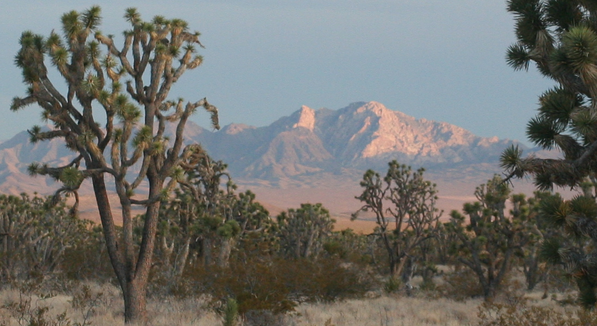Native Singers Keep Bird Songs Alive

One of the worst habits of modern American writers is that of referring to this continent's original inhabitants in the past tense. This is as true of the desert as anywhere in the U.S. It's understandable, in a way: Native people dominate the history, modern and ancient, of the desert. Writing about the desert's past without writing about Native people is just about impossible.
But there's more to the Native people of the desert than the seemingly permanent ancient rockworks and petroglyphs. Native people are still here, shaping the desert. A few, the Agua Caliente Cahuilla in my own Palm Springs being an example, have attained a certain measure of political and economic power. Others -- including some of the Agua Caliente's close neighbors -- still struggle for self-determination and respect. All of them work to defend and preserve their diverse cultures. And some aspects of that cultural diversity are far harder to preserve than a petroglyph or intaglio. Some are as ephemeral as a soft voice spoken in the desert wind.
Before European contact, California was one of the most linguistically diverse places on Earth, with between 70-100 languages spoken here. About half those have since gone extinct, and all are considered endangered -- meaning that children are not expected to be speaking them in 100 years, unless deliberate attempts are made to save them. For the last two centuries most Native Californians have grown up speaking either English or Spanish, and the number of fluent native speakers of each language dwindles.
California's desert people are no exception. Though spared the worst results of the population pressure from settlers seen in more comfortable climes such as Los Angeles and the Bay Area, native culture in the desert has had more than its share of disruption. Most of the California Desert's 16 or so native languages are in danger of extinction. If the languages go extinct, so will the traditions most crucial to the survival of a traditional culture: myth and song.
Fortunately, the information revolution now in progress offers at least a partial solution. Filmmakers and recordists are taking advantage of ever-cheaper recording technology and distribution channels to preserve at least some aspects of these threatened cultures.
California's desert languages can be divided into two large groupings: those belonging to the larger Hokan language family, and those that are part of the Uto-Aztecan family. Uto-Aztecan-speaking people, including the Shoshone, Paiute, Chemehuevi, Serrano, Vanyume and Cahuilla, covered most of the southern California deserts. Hokan-speaking people -- or more accurately, people who speak languages considered part of the Yuman-Cochimí subfamily of the Hokan language family -- lived along both sides of the Colorado River, from the Havasupai, Yavapai and Hualapai in Grand Canyon country to the Quechan and Kukupa near the delta, with the Mohave and Halchiduma in between.
Many of the Yuman-speaking peoples have similar origin myths, usually centering on Spirit Mountain near Laughlin, Nevada.
In late 2009 Quechan author, activist and storyteller Preston Arrowweed organized a group of singers from Yuman-speaking tribes up and down the Colorado River to come together to share the songs their cultures had in common. Filmmaker Daniel Golding, a Quechan himself, was in attendance, and the result -- the documentary "Songs of the Colorado" -- is now available on DVD. Here's the trailer:
Songs of the Colorado from Daniel Golding on Vimeo.
Golding and Arrowweed had worked together before, most notably on the 40-minute 2002 documentary "Journey from Spirit Mountain," which retraces the path from Spirit Mountain to the Quechan's present-day homeland, as detailed in the Quechan creation story.
The desert's Native people don't restrict their use of communications and recording technology to formal filmmaking. A quick tour through YouTube shows that Yuman-speaking people take full advantage of more flexible social media, as shown in this video of Mohave Bird Singers at a 2008 Indio PowWow. Note the participation of the next generation of bird singers at the far right:
The Bird Song tradition -- which has less to do with actual bird songs and more with creation stories and similar cultural myths -- has spread to non-Yuman people as well, as witness this group of Cahuilla bird singers:
And of course, no discussion of disseminating music on the Internet is complete without a link to the possibly moribund MySpace, which groups like the Aha Macav Avi Kwa Ame bird singers have been using for years. ("Aha Macav," "people who live by the water," is the origin of the word Mojave, and Avi Kwa Ame is the Mojave name for Spirit Mountain.)
Putting your traditional culture out on the Internet doesn't guarantee that it will survive unchanged, of course. Given the fact that some bird songs are properly sung only in a certain order certain settings at certain times of year, making portions of them available for year-round listening in YouTube snippets or on MySpace pages or on DVDs is likely to have unanticipated effects. Mass availability may well change the way Native people themselves view these songs.
Which just proves that this culture is still alive, still changing, still growing and adapting. That seems like a good thing.
You can purchase a copy of Songs of the Colorado by sending a check for $20.00 and $5.00 for shipping, made payable to Ah-Mut Pipa Foundation, P.O. Box 160, Bard, CA 92222
Chris Clarke is an environmental writer of two decades standing. Author of Walking With Zeke, he writes regularly at his acclaimed blog Coyote Crossing and works with the Desert Protective Council as Communications Consultant. Chris comments on desert issues here every Wednesday. He lives in Palm Springs.


